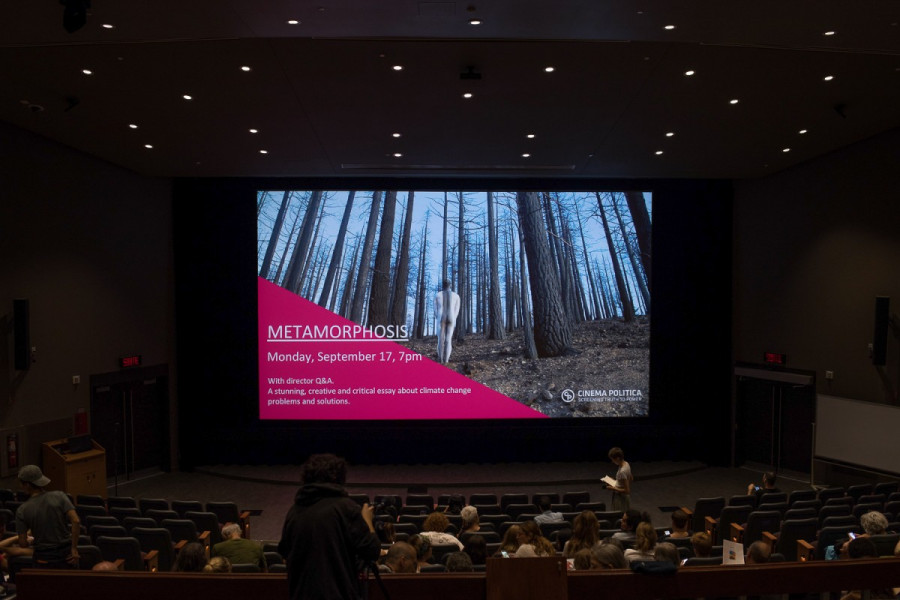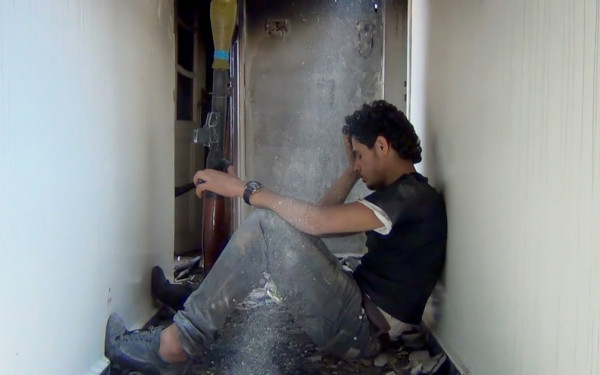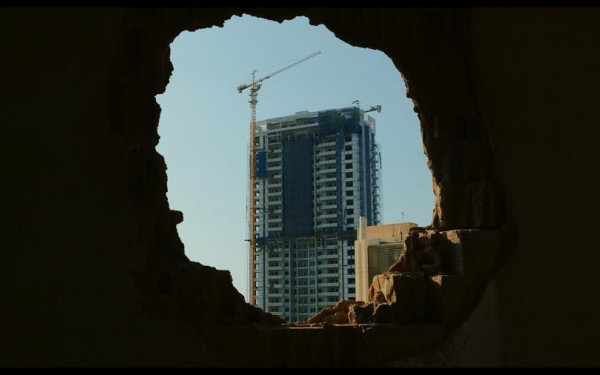Cinema Politica Opens Their Fall Screening Season With “Metamorphosis”
Nova Ami and Velcrow Ripper’s Documentary Delves into the Climate Change Discussion Through a Fine Art Lens
Last week marked the opening of Cinema Politica’s first screening of the season, aligning with the 15th anniversary of their first screening as an organization.
Cinema Politica is a Canadian non-profit group that promotes political, radical, and independent film and video art––and while a large group of directors and coordinators help to run the network, Cinema Politica relies on the help of volunteers to keep screenings running efficiently.
A diverse selection of films are on the docket for the next few months. Examinations of political upheavals in India will take place September 24th with Anand Patwardham’s Reason for example; and later in October, the screening of Polyland will explore Polish perspectives of women minorities. Each week at the end of every documentary, guest speakers⎼directors, collaborators, or representatives from activist groups⎼attend for an intimate question and answer session.
Metamorphosis
Metamorphosis, a film by Nova Ami and Velcrow Ripper, opened the season on Monday night.
The film documents the global climate change crisis through a fine arts lens, emphasizing that the root of it all, both environmental problems and their plausible solutions, originates in the capacity and necessity of change.
A voiceover in the beginning of the film reminds us that “coping with change is a deep, equisential question.” Earth’s systems innately change, and humans must also change to fix our damage to the planet. That thought travels throughout the film; both in how humans cope with the destructive effects of climate change, and how the process of change, of metamorphosis, is found in nature and the human psyche. This conviction guides the framework and content of the film.
The documentary highlights various effects of climate change. The film is established with imagery of monarch butterflies and continues with this metaphor throughout; their metamorphosis from caterpillar, to chrysalis, then butterfly. Entranced by their beauty, the viewer soon must face their destruction as changes in weather patterns inhibit their migration.
The state of California also arrives at the forefront of the film as issues of drought, wildfires, and consumption are examined. We see images of neighborhoods burning to the ground and the families that once inhabited them. Cell phone footage through a car window show this destruction; the panic and fear of unknown. Still portrait shots of survivors and of a family almost lost to flames establish a dark, even morbid, undertone.
In another scene, we see the starkness of U.S land that once flowed freely with water when inhabited by an Indigenous population. The cracks of dry earth create a geometric pattern that is both natural in curvature but unnatural in context. The desolation and dust combined with the voiceover of an Indigenous woman describing the landscape that once was feeds into a sense of nostalgia. We see lawns and pools in suburban towns that speak to our value of status and materialism. The enormity of their repetition is depicted from a bird’s eye view, portraying a suburban system that is overwhelmingly artificial. Footage of increasing high tides in the streets of Venice, Italy and the ruins of the Pacific island Vanuatu after Cyclone Pam contribute to a sense of worldwide dystopia.
What distinguishes this film, however, from a traditional documentary are the filming techniques. With considerable drone footage, geometric aerial views blur the line between real and abstract, and between massive and miniscule. The presence of monarch butterflies also structured the arc of the film, as explained by Nova Ami during the question and answer portion. There is a period of growth and of fear, but also a breakthrough filled with hope.
The combination of climate change with art also distinguished the film from other environmental documentaries. Sculpture and performance are huge aspects of the film, making the environmental footage a stage for theatrics and human performance.
Inserted between the more traditional documentary scenes are video art pieces, for example, that show two nude human bodies either standing, laying, or sitting in various natural landscapes, like the sand of a beach. The shadows of the bodies create an extension of the flesh itself, creating forms that become statues rather than human bodies. Here, the filmmakers played with shadow and size in landscapes that are both familiar once revealed, but filmed futuristically.
The macro imagery and playfulness with speed proves to be melodic, and the slowness and intention of the footage urges society to slow down our institutional growth, and find intention in our everyday practices. Here is where feelings of beauty and hope are incorporated, where we see the film grounded in emotion.
The second half of the film calls attention to solutions for the climate change crisis. Artistically, the underwater sculpture work of Jason deCaires Taylor is brought in, showing how his art practice can become operational coral reefs. He creates molds out of the human body, and these human sculptures are placed at the bottom of the ocean. They are beautiful in nature; when placed underwater, and transformed into coral reefs, the human shapes become one with the ocean’s system. These reefs help to create shelter and food for organisms. While this isn’t a solution that anyone can easily try, the filmmakers purposely intended to show how art, in all parts of the world, can become transformative for our environmental problems.
Other innovative solutions include modifications to suburban homes; from altering backyard pools into gardens that double as ecosystems, or providing solar energy to lower income families, these inventive options feel more accessible. The solutions offer hope despite crisis and are framed in both artistic practice and altered human behaviour.
The audience on Monday night seemed impressed by the high quality of the imagery and its artistic value; questions for the filmmakers almost always began with praise for how beautiful the shots were.
Nova Ami and Velcrow Ripper made their mark in the conversation through an impressive art-based documentary created within a tension of desolation and hope.
However, it’s important to question the ethics of the film’s approach. How beneficial is it to frame catastrophic issues, spoken in a manner of hopelessness, in a pretty and theatrical way? In one sense it establishes relatability, becoming accessible to a viewer’s emotions. But should we view disaster, such that is solely at the fault of humankind, through a lens of beauty? As the film alludes to, defining aspects of our identities such as materialism and consumerism must change for any long term solutions to materialize⎼so how can this be accomplished?
Cinema Politica’s next screening of Anand Patwardhan’s “Reason” will be on Sept. 24 at 6 p.m., at Room H-110 in the Hall Building, located at 1455 de Maisonneuve Blvd. W.




_600_375_90_s_c1.jpeg)


